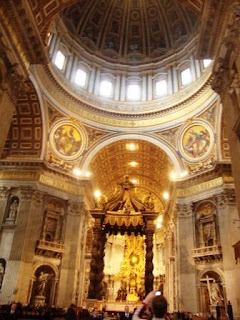One of Amy’s favorite places in Italy is Cerveteri. She has often taken her students there when she traveled with them from the US. However, Emily was interested in a slightly different experience as she wanted to have a viewing of the Mediterranean. So, we headed more directly west and landed in Tarquinia. We visited the modern city earlier this year with the H-P’s for lunch on the way to somewhere, but I haven’t really explored there for the better part of a decade.
We began our day at the Lido di Tarquinia, the small beach community just west of the city. During the summer season, any town with Lido as part of its name is overrun by tourists. Italians come there during August to coat themselves in olive oil and bake themselves into a stupor. At this time of year, there are only a handful of businesses open and most of the summer apartments are boarded over and vacant. It is so deserted they have even taken away the meter where you pay for your parking! We wandered the black sand beach with a few dog walkers and fishermen past boarded businesses and rows of brightly colored changing huts.
Here Emily as returning from taking a picture at the end of a stone jetty. A few moments earlier she had been so distracted by her picture taking that she ended up ankle deep as a wave caught her.
There is a nifty inset stone compass which names the winds. Each of the 8 principle points of the compass has a wind named for it. Winds from the Southeast are called the Scirocco. During the summer they bring the scalding heat of the desert. During the winter those same winds pick up humidity as they cross the sea and bring rain along with warmer temperatures.
We were unable to find anyplace open for lunch at the beach, so we returned to town to eat and then made our way to the Etruscan necropolis, or city of the dead, on a ridge outside of the current town. Here we have a view across to the hill where the original Etruscan settlement was.
Tarquinia along with Cerveteri are the two most important necropoli in the region although lesser ones are dotted everywhere, including the more immediate region of Viterbo. It is hard not to compare the two, as they are very different. At Cerveteri you get the feeling of walking in a city. It gave archeologists an important look at an Etruscan city plan. Everything is open and a visitor can walk directly into many of the tombs. Tarquinia is much more subtle. Most of the huge burial mounds are gone. What you see as you enter the site is a large field dotted with hut-like structures. Of the more than 6000 tombs that have been explored, only a few have been left on display. What is unique about them is the state of preservation of the wall paintings, some of which date back 2500 years or more. These paintings give us a glimpse of the culture and traditions of the Etruscans.
From them we can see what they would have worn, the games they would play, the ceremonies they held and even the animals they hunted and revered. In order to preserve the paintings, they have sealed the rooms and regulated the environment within. The hut-like buildings are the entrances to each of the tombs. The best you can do is to stand at the door and take pictures.





















































